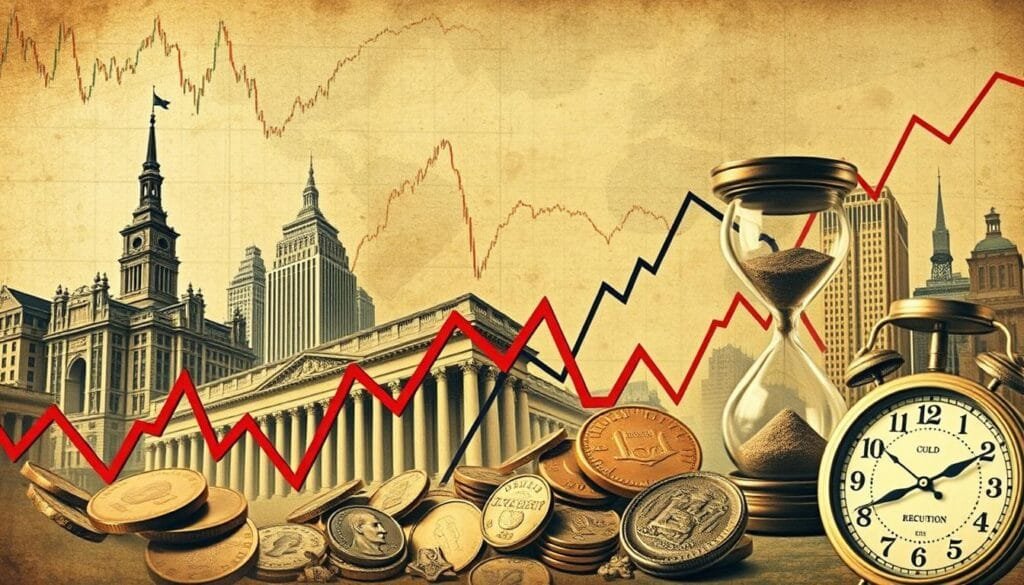Can we really predict recessions accurately? In today’s world, economic downturns often catch us by surprise. Experts, like Jared Bernstein, highlight the unpredictability of economic declines. This makes us wonder about the reliability of economic forecasts.
The challenge in predicting recessions accurately is huge. It involves complicated global economic factors and unexpected events. Think about the impact of random shocks or central bank decisions.
The Confederation Board Leading Economic Index gives a glimpse up to a year ahead. The U.S. Leading Economic Index warns us of market trends 1-3 months before they happen. But predicting economic slowdowns becomes much harder after a year.
We are looking into how reliable these economic predictions really are. This includes looking back at past predictions and the methods used today in forecasting business cycles.
Key Takeaways
- The Confederation Board Leading Economic Index has up to one year of forecasting capabilities.
- The U.S. Leading Economic Index (LEI) signals market trends 1-3 months prior to downturns.
- Accuracy decreases significantly beyond a year in recession forecasting.
- Inverted yield curves offer a warning window of 6 to 22 months for recessions.
- Economic projections often miss the mark, demonstrated by historical inaccuracies during major economic downturns such as the 2001 and 2008 crises.
- A study from 1992 to 2014 showed economists missed the majority of the 153 recessions studied.
- Advances in predictive analytics and technology may improve short-term forecast reliability.
Introduction to Economic Forecasting
Economic forecasting is key to predicting business cycles. It uses different statistical tools and methods. Analyzing indicators like GDP and unemployment rates is common. These insights help investors and policymakers plan for the future.
Predicting downturns or growth depends on these indicators’ accuracy.
The yield curve analysis is a famous model for predicting recessions. For example, in mid-2019, the yield on ten-year U.S. Treasury notes fell below the three-month bills yield. This was seen as a sign of an upcoming recession. Research shows that this model accurately forecasts recessions up to twelve months ahead.
The Conference Board Leading Economic Index (LEI) is another effective tool. It uses ten leading indicators for forecasts. It has shown strong predictive power, especially during recessions. When combined with the yield curve analysis, the accuracy improves, and false alarms decrease.
However, not all indicators are equally reliable. For instance, new unemployment claims were the least predictive.
In summary, the best forecasting methods use various indicators. Models like the yield curve and LEI adjust well to economic changes. This flexibility was vital during the COVID-19 pandemic, which challenged traditional models.
Challenges in Predicting Recessions
Predicting recessions is hard due to complexities and uncertainties. Even with new models, accuracy is often challenged by various factors.
Random Economic Shocks
Unexpected economic shock impacts are hard to predict. These can be anything from financial crises to sudden geopolitical events. They change economies fast, making models miss the mark.
Complexity of Economic Models
Economic models are complex. They mix many variables that affect global economies. It’s tough to track how these elements interact and impact outcomes. This makes precise predictions hard to come by.
Forecasting Errors
Forecasting errors happen a lot. They often come from differences between what was expected and what actually happens. History shows these mistakes frequently, showing the limits of current models. Even the best tools can’t catch all surprises, highlighting ongoing challenges.
Recession Indicators and Their Limitations
Understanding recession indicators and their limits is vital in the economic world. Our focus is on two main areas: yield curve analysis and economic indicator indexes. These methods are key in forecasting recessions but have their own set of challenges.
Yield Curve Analysis
The inversion of the yield curve is a strong predictor of recessions. When short-term rates go above long-term ones, recession often follows. This method predicted 9 of the last 10 recessions. However, it’s not perfect.
Changes in monetary policy and the global economy can affect the yield curve. Despite its track record, from 1965 to 2019, the yearly chance of a recession was only about 12.73%. This shows the need to consider other economic factors too.

Economic Indicator Indexes
The Conference Board’s Leading Economic Index (LEI) uses multiple indicators to check the economy’s health. It looks at consumer confidence, stock prices, and manufacturing orders. This index has been crucial in predicting downturns, though with limited accuracy. For instance, in March 2022, it saw only a 5% chance of a recession.
Yet, these indexes aren’t perfect. Things like surprise economic events or policy shifts can cause them to be wrong. Also, combining different indicators can weaken their predictive ability. Studies have shown that mixed signals, like low unemployment with high inflation, can confuse the forecast, sometimes indicating a 50% chance of recession over a year.
In the end, both yield curve forecasting and economic indexes are vital for predicting downturns. But it’s important to remember their limits. Using a mix of economic factors can lead to better forecasts.
An Analysis of Historical Accuracy
When we look at how well experts have predicted recessions, we see mixed results. Financial models, like those focusing on yield curves, are sometimes good at spotting downturns. But their accuracy changes with different economic conditions and times.

Short-term forecasts, using things like Treasury yield curves and the Leading Economic Index, tend to be more accurate. But, making long-term predictions is harder. The further out these forecasts go, the less we can trust them.
For instance, the Leading Economic Index is quite reliable for the near future. It has a high AUC value of 0.97. But the long-term predictions using Treasury yield spreads are less reliable. Their accuracy dips from 0.89 at 14 months to just 0.75 by 24 months.
The table below shows how different forecasting models stack up over time. It gives us a clearer picture of their accuracy.
| Forecast Model | Timeline | AUC Value |
|---|---|---|
| Conference Board Leading Economic Index (LEI) | 1-3 months | 0.97 |
| Long-term Treasury Yield Spread | 14 months | 0.89 |
| Long-term Treasury Yield Spread | 24 months | 0.75 |
| Leading Indicators (Average) | 10-13 months | 0.84-0.89 |
In summary, some models like yield curves and leading indexes do well at predicting recessions. However, the accuracy of these tools varies over time. The complex nature of the world economy makes forecasting a tough job. Forecasters have to deal with many uncertainties.
Impact of Big Data and Technology on Forecasting
Big Data has changed the game in economic forecasting. Now, economists have more data from many places. They use advanced machine learning to make their forecasts better and faster. The power of AI lets them analyze huge datasets quickly, bringing new insights.

Still, forecasting is hard due to the economy’s complex nature. For example, in the U.S., we look at the chance of a recession differently. We define a recession as two quarters of shrinking GDP. Forecasts usually look 12 months ahead.
Economists use 8 variables to guess recession chances in a probit model. This model can overfit data and miss signs of a downturn. It was tested during two recessions from 2000 to 2010. A special indicator measured its accuracy.
Big Data lets researchers use the latest data, even if it might change later. This improves their guess at a recession happening in the next 12 months. AI can handle many variables at once, making models that can predict things outside usual data.
Machine learning beats traditional methods in specific tasks. It’s better at fitting models and validating them. It excels in areas like reading comprehension and complex games like Go. This technology is making forecasts more accurate.
| Component | Details |
|---|---|
| U.S. Recession Data | June 1978 – January 2023 |
| Recession Definition | Negative GDP growth for two consecutive quarters |
| Forecasting Horizon | 12 months |
| Predictive Variables | 8 economic indicators |
| Model Type | Probit Model |
| Challenges | Overfitting, Missing Lead Times |
| Performance Measurement | Separation Indicator |
| Study Period | January 2000 – January 2010 |
| Backtesting Events | Two recessions |
| Estimation Method | Maximum Likelihood Estimation |
In conclusion, Big Data and AI forecasting give us an edge in predicting downturns. But, the economy keeps changing. We must always improve and adapt these tools for the best forecasts.
How accurate do you think economics are at predicting recessions
Looking into how well we can predict economic downturns is very interesting. The track record is mixed. For example, in early 2001, experts thought the economy would grow by 2.5% in a year. In reality, it grew by just 0.5%. Before the Great Recession, forecasts missed the mark again. Analysts predicted 2.2% growth whereas it barely reached 0.6%.
A survey from the National Association of Business Economics found that 38% of economists expected a recession soon. Another survey saw a 33% chance of recession in the next year. Still, real-world events often prove these predictions wrong. Very few recessions have been accurately predicted 9 to 12 months ahead, as noted by economist Prakash Loungani.
One sign of an upcoming recession is the yield curve inverting. This has been a reliable indicator, typically hinting at a recession within 6 to 22 months. However, its effectiveness can be swayed by how investors feel, making it not a sure thing. Campbell Harvey suggested that a yield curve inversion lasting three months usually points to a downturn. Yet, the investor reaction can change the outcome greatly.
Analysis from a 2018 study looked at recessions in 63 countries between 1992 and 2014. It found that most of these economic declines were not predicted by economists. Even the severe 2008 crisis wasn’t recognized as a recession until it had been happening for almost a year. This shows how hard it is to forecast economic downturns accurately.
Improving our ability to predict recessions requires using various indicators. By evaluating economic forecasts like the 10Y3M Treasury spread and other tools, we seek to better our predictions. However, crafting reliable forecasting models is tough. This challenge keeps the debate on economic forecasting alive and well.
Exploring Short-Term vs Long-Term Predictions
Understanding economic forecasts is key. A big divide lies between predicting the near future and long-term recessions. Both predictions come with their own sets of challenges and accuracy levels.
Short-Term Prediction Accuracy
Short-term forecasts are more precise due to real-time economic data. As of July 2018, the 10y–3m spread showed a slightly under 1% level. This indicates stable economic conditions. Immediate data helps make these forecasts more trustworthy.
The accuracy of short-term predictions is high, with AUC scores between 0.85 and 0.89. This shows they are reliable. From 2009-2015, short-term forecasts were as accurate as long-term ones. This confirms their effectiveness in predicting the near future.
Long-Term Prediction Challenges
Long-term predictions face more uncertainties. Political events, technological changes, and global shifts make long-term forecasts volatile. Adjusted term spreads are less precise than traditional ones. This underlines the complex nature of long-term predictions.
The track record of yield-curve inversions is impressive. Every recession since 1977 was announced by an inversion. However, predicting long-term changes remains tough despite past success.
Quantitative easing affects long-term yields negatively. It adds uncertainty. Studies on QE show a wide statistical range on its impact. This complicates long-term forecasting further.
| Economic Indicator | Predictive Accuracy (AUC) | Notable Details |
|---|---|---|
| 10y-3m Spread | 0.88 | Highest predictive reliability among tested spreads |
| 10y Exp-3m Spread | 0.85 | Less accurate predictor compared to unadjusted term spreads |
Conclusion
Exploring economic recession forecasting reveals it blends art and science. Data shows a complex picture. Tools like the yield curve are important but not always right. The AUROC statistics indicate that many models are as good as guessing.
Improving economic forecasting means making our tools better. We need to use big data from different economic areas. For example, the yield curve model is a good predictor for 6 to 20 months ahead. But, we must watch for changes in the world economy.
Changes over the last 70 years have made forecasting harder. This shows we need to keep updating our methods.
To get better at predicting, we must recognize the uncertainty in our economic forecasts. Mistakes are common, and big downturns are often missed. Still, using both short-term and long-term data is critical.
Looking ahead, big data and machine learning will be important. These advancements can make our predictions more precise. Combining smart models with up-to-date data is our path to better understanding the economy’s future.
FAQ
How reliable are economic forecasts in predicting recessions?
Economic forecasts often have a hard time predicting recessions. This is because of unexpected economic shocks and many global factors at play. Jared Bernstein highlights these issues.
What methods are used in economic forecasting?
To forecast the economy, experts use many statistical tools. They analyze things like GDP, unemployment rates, and consumer spending. More complex models are also used.
Why is it challenging to predict recessions?
Predicting recessions is tough due to unpredictable economic shocks. The complexity of models and common errors also make it hard. This makes accuracy difficult.
What are some common recession indicators?
Certain signs indicate a recession, like yield curve analysis. Economic indexes, such as the Conference Board’s Leading Economic Index, are also used. Their success can depend on the current economy.
How accurate have historical recession predictions been?
Looking back, predictions about recessions have a mixed success rate. Key recessions in 2001 and 2007 were largely underestimated. This shows how hard it is to keep predictions consistent.
How has Big Data and AI impacted economic forecasting?
The introduction of Big Data and AI has made economic forecasts faster and more precise. They allow for detailed analysis in real time. Yet, these advances have their limits within the complex economic landscape.
Can economics reliably predict recessions?
Short-term predictions have gotten better thanks to improved indicators and technologies. However, long-term forecasts still face big challenges. Unforeseen political events, tech changes, and world economy shifts make it difficult.
What are the differences between short-term and long-term economic predictions?
Short-term predictions are generally more accurate. This is because they use immediate indicators and new tech. Long-term forecasts, however, deal with more uncertainties. These affect their reliability.
